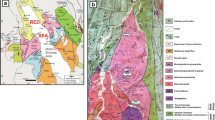Abstract.
An SEM, REE, and mineral Sm–Nd isotope study on olivine-plagioclase coronas in the Vestre Dale gabbro, Norway, was carried out in order to solve the temporal relationships within these coronas. It is demonstrated that in contrast to common models, corona formation is a multistage, late-magmatic process, starting with the formation of orthopyroxene by (partial) dissolution of olivine, followed by the nucleation and rapid outward growth of orthopyroxene+spinel symplectites at its outer margin, and concluded by replacement of this precursory outer shell by calcic amphibole. Isotopic equilibrium between inner shell orthopyroxene and the magmatic assemblage, and the REE contents of orthopyroxene and outer shell amphibole also provide strong arguments for a magmatic origin, with the local availability of fractionated magma acting as a limiting factor. The absence of replacement of intercumulus clinopyroxene by amphibole also favours a late stage magmatic rather than a metamorphic origin for corona amphibole.
Similar content being viewed by others
Author information
Authors and Affiliations
Additional information
Electronic Publication
Rights and permissions
About this article
Cite this article
de Haas, GJ.L., Nijland, T.G., Valbracht, P.J. et al. Magmatic versus metamorphic origin of olivine-plagioclase coronas. Contrib Mineral Petrol 143, 537–550 (2002). https://doi.org/10.1007/s00410-002-0362-9
Received:
Accepted:
Issue Date:
DOI: https://doi.org/10.1007/s00410-002-0362-9




